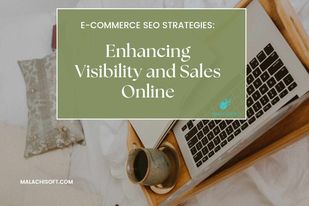Introduction: In the world of e-commerce, where thousands of online stores compete for consumer attention, having a well-optimized website is crucial for success. E-commerce SEO (Search Engine Optimization) is the key to enhancing your store’s visibility and driving more sales. In this blog, we will explore effective e-commerce SEO strategies to help your online store stand out in the digital marketplace and boost your sales.
1. Keyword Research and Targeting:
Keyword research is the foundation of any successful e-commerce SEO strategy. Start by identifying relevant keywords that your potential customers might use to find products similar to yours. Tools like Google Keyword Planner and SEMrush can assist in this process. Optimize product titles, descriptions, and meta tags with these keywords to improve your website’s search engine rankings.
2. High-Quality Product Descriptions:
Well-crafted product descriptions not only inform potential buyers but also contribute to your SEO efforts. Create unique and informative descriptions for each product. Include relevant keywords naturally and provide details that answer common customer questions.
3. Optimize Product Images:
Optimizing images is a crucial e-commerce SEO practice. Use descriptive file names and alt tags for your product images. This not only improves SEO but also enhances the user experience for visually impaired customers.
4. Implement Structured Data (Schema Markup):
Implement schema markup on your e-commerce site to provide search engines with additional information about your products. This can lead to rich search results, including product ratings, prices, and availability, which can make your listings more attractive to potential customers.
5. Mobile Optimization:
With the increasing use of mobile devices for online shopping, mobile optimization is a must. Ensure that your e-commerce website is responsive and offers a seamless experience on smartphones and tablets. Google considers mobile-friendliness as a ranking factor, so it’s crucial for SEO.
6. User-Friendly Navigation:
A clear and intuitive website navigation not only helps users find what they’re looking for but also improves SEO. Use logical categories and subcategories, breadcrumb navigation, and user-friendly filters to enhance the overall user experience.
7. Content Marketing:
Regularly publish informative and engaging content on your website. Blog posts, buying guides, and product reviews can help establish your authority in your niche. Quality content attracts backlinks and keeps visitors on your site longer, which positively impacts your SEO.
8. Internal Linking:
Effective internal linking can help distribute link equity throughout your website, improve user navigation, and enhance SEO. Link product pages to related items, suggest complementary products, and create a user-friendly interlinking structure.
9. Customer Reviews and Ratings:
Customer reviews and ratings can improve your SEO efforts by providing fresh, user-generated content. Positive reviews also enhance trust and credibility, which can lead to higher click-through rates and conversions.
10. Page Speed and Technical SEO:
Optimize your e-commerce site for fast loading times and ensure that it’s technically sound. Search engines favor websites that provide a smooth user experience. Compress images, enable browser caching, and fix any technical issues that may hinder your SEO performance.
11. Secure and Mobile-Friendly Site:
Secure your website with an SSL certificate, and make sure it’s mobile-friendly. Google ranks secure and mobile-optimized websites higher in search results.
12. Monitor and Adapt:
Keep a close eye on your SEO efforts with tools like Google Analytics and Search Console. Analyze your data, track rankings, and adjust your strategy based on performance metrics.
Conclusion: E-commerce SEO is a dynamic field that requires continuous attention and adaptation. By implementing these strategies, you can enhance the visibility of your online store and, in turn, drive more sales. Remember that SEO is an ongoing process, and staying updated with the latest industry trends is key to long-term success in the competitive e-commerce landscape.
